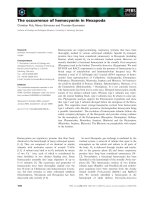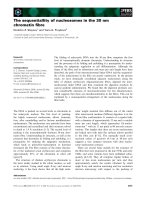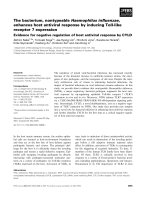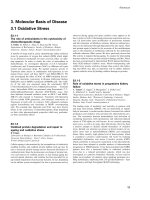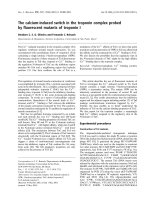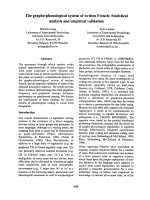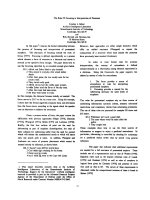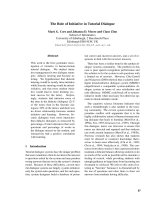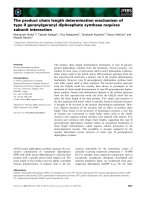Báo cáo khoa học: "The Nature off Affixing in Written English, Part II" pptx
Bạn đang xem bản rút gọn của tài liệu. Xem và tải ngay bản đầy đủ của tài liệu tại đây (386.05 KB, 11 trang )
[Mechanical Translation and Computational Linguistics, vol.9, no.2, June 1966]
The Nature off Affixing in Written English, Part II
by H. L. Resnikoff and J. L. Dolby, The Institute for Advanced Study,
Princeton, New Jersey, and R & D Consultants Company, Los Altos, California
This is a continuation of the authors' paper of the same title which
appeared in Volume 8 of this journal. The present part extends the
authors' definitions of prefix and suffix (in written English) to corpora
of three-vowel-string words, and implements them on a corpus
K con-
sisting of 19,329 graphemically distinct three-vowel-string words from
the Shorter Oxford Dictionary. The notion of a parasitic affix is intro-
duced, and the parasitic suffixes for K are determined.
This paper is a continuation of reference 1 (which will
be called Part I throughout). In that paper
1
a sys-
tematic procedure for finding English affixes was briefly
described, and the results of applying the procedure to
the
CVCVC words in the Shorter Oxford English Diction-
ary were given.
Here we will present several refinements of the pro-
cedure used in Part I and apply the technique to the
study of affixes in the three-vowel-string words, that is,
CVCVCVC words.
There are some novelties which arise. Among these,
the most important is certainly the occurrence of suf-
fixes which primarily occur attached to other suffixes.
Evidently these could not be found from an investiga-
tion of the two-vowel-string words, and so they did not
make their appearance in Part I. Another new feature
is the occurrence of two-vowel-string affixes, which
cannot occur in two-vowel-string words for obvious
reasons.
Except where otherwise noted, the terminology and
definitions are those used in Part I.
The reader should note the recently published work
of Monroe,
2
which forms an interesting complement to
our investigations,
Notational Refinements
Before coming to the proper subject of this paper we
would like to make corrections to Part I and to intro-
duce some minor refinements of notation.
The weak suffix -
Y should be added to Table III of
Part I. The classes Cls(
NCH/Y) and Cls(FF/Y), among
others, testify to the existence of this affix. Also, in the
penultimate paragraph, read -
IST for -ous.
We turn now to the notational refinements. From
Volume 2 of The English Word Speculum
3
it can be
seen that the letter
Q in initial position is always fol-
lowed by the letter
U with only one occurrence of the
sequence
QY. Since there are fewer than four exceptions
to the statement that
Q is always followed by U in initial
position, this will be taken as a universal property of
English words. Using the terminology of Part I, the
sequence
QU is the only admissible initial sequence be-
ginning with
Q.
Similarly, from Volume 3 of The English Word
Speculum, we find that the only words that end with
the letter
Q are SEQ and ESQ. Again there are fewer than
four words ending with
Q, and so it is clear that Q alone
does not occur admissibly in either initial or final posi-
tion in English words.
A somewhat more tedious examination of Speculum
3 (this mode of reference to particular volumes of ref-
erence 3 will be used hereafter) shows that
Q is always
followed by
U with the exceptions noted above. For
this reason, the letter sequence
QU can be treated as a
single unit in the words in which it occurs. Such a
letter sequence which functions as a distinct unit in all
contexts will be called a “generalized letter,” and all
generalized letters are classified as consonants. Through-
out this paper we will assume that the sequence
QU is
a generalized letter and hence a consonant. With this
assumption it is worth noting that the string
QUE is an
admissible final-consonant string, occurring in words
like
MASQUE.
Because only the admissible final-consonant strings
not ending with E were used to determine the affixes in
Part I, the addition of the admissible final-consonant
string
QUE does not influence the results of that paper.
However, the generalized letter
QU should replace the
letter
Q in the first section of Table I of Part I.
The fact that
QU is assumed to be a generalized letter
will have an effect on the syllabic decomposition of cer-
tain words constructed like
QUADRILATERAL, where the
first vowel string must now be interpreted as the single
vowel
A, since QU is a consonant.
From Table 3 of a previous study,
4
we see that x is
the only consonant that is not an admissible initial con-
sonant, and Table 6 of the same paper shows that j
and
QU are not admissible final consonants. Hence, in
the terminology of Part I, there is a mandatory decom-
position point as indicated in each of the following se-
quences:
V
1
X — V
2
, V
1
— JV
2
, and V
1
— QUV
2
,
where
V
1
and V
2
are arbitrary vowel strings. In order to
simplify both the notation and presentation, we will
make the convention that these letter sequences be
interpreted as standing for the sequences
23
V
1
XφV
2
, V
1
φ
JV
2
, and V
1
φ
QUV
2
,
where
φ
denotes the blank consonant. In this way the
definitions of prefixes and suffixes given in Part I be-
come applicable to words containing the letters
X, J,
and
QU without any alteration.
The procedure just described was tacitly followed in
Part I; Table I there showed that the mandatory de-
composition points given above exist for these letters.
The only consequence drawn from these assumptions
in Part I was that
EX- is a strong prefix in the two-
vowel-string corpus that was examined there. This con-
clusion is not altered by our present conventions.
Modified Definitions
The affix definitions given in Part I referred specifically
to a two-vowel-string corpus. Here we will consider
a three-vowel-string corpus, and so the definitions must
be modified accordingly.
Let
K be a fixed corpus of three-vowel-string words,
and let the words belonging to K be given in the form
C
1
V
1
C
2
V
2
C
3
V
3
C
4
.
Definition P1. Let
P = C
1
V
1
C
2
' (resp. P = C
1
V
1
C
2
V
2
C
3
') be
a fixed initial-letter string.
P is called a
strong prefix (with respect to
K) if there
exist two distinct classes of words from
K,
Cls(
P/C
I
") and Cls(P/C
II
"), each of
which contains more than three words,
such that
C
2
'C
I
" and C2'C
II
" (resp. C
3
'C
I
" and
C'C
II
") are mandatory decomposition
points of the second consonant string
C
2
(resp. the third consonant string
C
3
).
This definition parallels that given in Part I, but makes
it possible to consider two-vowel-string prefixes. The
corresponding definition of a strong suffix is this:
Definition S1. Let
S = C
3
"V
3
C
4
(resp. S = C
2
"V
2
C
3
V
3
C
4
)
be a fixed final-letter string.
S is called a
strong suffix (with respect to
K) if there
exist two distinct classes of words from
K,
Cls(
C
I
'/S) and Cls(C
II
'/S), each of which
contains more than three words, such that
C
I
'C
3
" and C
II
'C
3
" (resp. C
I
'C
2
' and C
II
'C
2
")
are mandatory decomposition points of
the third consonant string
C
3
(resp. the
second consonant string
C
2
).
In an analogous fashion, the definitions of weak pre-
fix and weak suffix given in Part I are generalized to
apply to a three-vowel-string corpus.
Definition P2. Let
P = C
1
V
1
(resp. P = C
1
V
1
C
2
V
2
) be
a fixed initial-letter string.
P is called a
weak prefix (with respect to
K) if there
exist two distinct classes of words from
K,
Cls(
P/C
I
) and Cls(P/C
II
), each of which
contains more than three words, such that
C
I
and C
II
are admissible initial-consonant
strings. Here
C
I
and C
II
are the entire
second (resp. third) consonant strings of
words from
K.
Definition S2. Let
S = V
3
C
4
(resp. S = V
2
C
3
V
3
C
4
) be a
fixed final-letter string.
S is called a weak
suffix (with respect to
K) if there exist
two distinct classes of words from
K,
Cls(
C
I
/S) and Cls(C
II
/S), each of which
contains more than three words, such that
C
I
and C
II
are admissible final-consonant
strings. Here
C
I
and C
II
are the entire
third (resp. second) consonant strings of
words from
K.
It will turn out to be necessary to consider a still
weaker definition of affixes, but this must wait until the
consequences of the four definitions presented above
have been examined.
The admissible initial- and final-consonant strings of
English words play a critical role in the application of
all four of the definitions, because the notion of a man-
datory decomposition point, as defined in Part I, is
rooted in explicit knowledge of the admissible conso-
nant strings. This information, taken from reference 4,
and presented in Table I of Part I, will be used re-
peatedly in the application of the definitions given in
later sections of this paper.
One other matter must be decided before the defini-
tions can be applied. It may happen, for instance, that
the sequence
P' is a prefix and the longer sequence
P" = P'X is also a prefix, where x is a non-blank letter
string. It is intuitively unsatisfactory to permit a word
belonging to an admissible class Cls(
P"/Y") to appear
in one of the defining classes Cls(
P'/Y'). Therefore, we
make the convention that words appearing in an ad-
missible class for an affix
A are to be excluded from
membership in all classes for affixes contained in
A.
Thus a word belongs to the admissible class of the
longest affix it contains.
As a concrete illustration, consider the suffixes -
LY
and -
Y. Since -LL is a popular admissible final-conso-
nant string, there are many three-vowel-string words
ending with -
LLY. If -Y is under examination, we would
be tempted to consider Cls(
LL/Y) to show that -Y is a
suffix. Since -
LY is a suffix, it is not clear that the de-
composition
LL-Y is appropriate; perhaps L-LY is cor-
rect in certain circumstances. Application of the con-
vention requires that the decomposition
L-LY be con-
sidered; according to the definition, only classes with
mandatory decomposition points can be considered to
determine the strong suffixes. Since -
LL is an admissible
final-consonant string,
L-LY is not a mandatory decom-
position point, and so Cls(
L/LY) cannot be considered
as a defining class for -
LY either. Hence the effect of the
convention is to delete from the corpus the words of
the form -
LLY which may involve more than one dis-
tinct suffix.
As a second illustration, consider the suffixes -
ICAL
and -
AL. The convention requires that the words in
the admissible classes defining -
ICAL not be used in the
classes defining -
AL. For the corpus described in the
next section, this means that words ending with -
PTICAL
24
RESNIKOFF AND DOLBY
WRITTEN ENGLISH, PART II
25
26
RESNIKOFF AND DOLBY
and -RTICAL are not included in classes of the form
Cls(
C/AL).
The Corpus
The definitions presented in the previous section make
it apparent that the set of affixes (that is, prefixes and
suffixes) that they determine depend implicitly on the
corpus
K. In general, a small corpus will not provide
all of the affixes that can be obtained from a larger
corpus, so that it is desirable to implement the defini-
tions on as large a corpus as is practical. On the other
hand, there is no a priori assurance that the set of af-
fixes becomes stable once the corpus includes some
certain fixed subcorpus. That is, it might be the case
that continually increasing the size of the corpus con-
tinually increases the size of the affix set. This is a diffi-
cult problem, for which a direct answer is not likely to
be obtainable. There are certain indirect ways of in-
vestigating whether the affix set tends to become stable
for sufficiently large corpora, but these are all rather
elaborate and require an extensive analysis which can-
not be attempted here. Nonetheless, the importance of
this problem should not be overlooked.
We have chosen to implement the affix definitions on
the corpus
K of three-vowel-string words given in Spec-
ulum 2. Note that the collection of three-vowel-string
words in Speculum 3 coincides with this corpus. The
corpus can also be described as the collection of all
three-vowel-string boldface left justified words from
the Shorter Oxford English Dictionary which have the
property that their parts of speech (as indicated by
either the Shorter Oxford or the Merriam-Webster New
International Dictionary, 3d edition) are included in
the categories “noun,” “adjective,” “verb,” “adverb.”
The primary reason for choosing
K in this way is that
this corpus is displayed in the Speculum in a manner
convenient for the implementation of the affix defini-
tions. Its size is another attraction: it consists of 19,329
WRITTEN ENGLISH, PART II
27
graphemically distinct words and thus is reasonably
large but still permits detailed human examination. It
may be helpful to remark that the total number of
three-vowel-string words in the Shorter Oxford English
Dictionary is 20,762, so that the corpus
K contains
about 93 per cent of all of the three-vowel-string words
in this medium-size dictionary.
Results
The results of applying the definitions given above to
the corpus
K are assembled in Tables 1 and 2, devoted
to prefix data and suffix data, respectively. In each of
these tables the letter string under examination is listed,
and those admissible classes containing the given letter
string are shown together with the number of words
they contain. Since only admissible classes are tabu-
lated, the corresponding numbers are all greater than
3.
For convenience, the class Cls(
X/Y) has been writ-
ten in the abbreviated form (
X/Y) in the tables.
In accordance with the procedures described by the
definitions and augmented by our conventions, the
strong and weak affixes with respect to
K are precisely
those letter strings that correspond to at least two
classes in Tables 1 and 2.
Examining Table 1, we see that of the sixty-three
initial-letter strings represented, twenty-two are pre-
fixes; from Table 2, of the seventy-six letter strings,
forty-seven are suffixes. Thus the procedures used in
constructing these tables produce a relatively high pro-
portion of affixes compared to the total number of letter
strings corresponding to admissible classes.
The set of affixes that compose Table 3 is somewhat
different from the set of affixes found in Part I from the
two-vowel-string corpus. There are fifteen prefixes that
appear in both Part I and Table 3 of Part II, but Part I
lists the six prefixes
BE-, CY-, I-, OUT-, SUN-, TRANS-,
that do not appear in Table 3, while the seven prefixes
AN-, OB-, OVER-, PRO-, PU-, SE-, VI-,
are in Table 3 but not in Part I. Of these latter,
OVER-
is a two-vowel-string prefix and so could not have ap-
peared in Part I.
There are twenty-six suffixes that are common to
Part I and Table 3 of Part II. The following twenty-
five suffixes are in Part I but not in Part II:
-
ED, -LAND, -ARD, -WARD, -EE, -IE,
-
ING, -LING, -AH, -OCK, -LOCK, -EL,
-
MAN, -EN, -EON, -IER, -LER, -LESS,
-
IS, -NESS, -AT, -LET, -OT, -OW, -EY,
and twenty-one suffixes are in Table 3 of Part II but
not in Part I:
-
ANCE, -ENCE, -IDE, -ABLE, -IBLE,
-
ISE, -OSE, -ATE, -IZE, -ICAL, -IAL,
-
ISM, -IUM, -IAN, -ATION, -ESS, -OUS,
-
IOUS, -ARY, -ERY, -RY.
Of these, -
ICAL, -ATION, -ARY, and -ERY are two-vowel-
string suffixes, and so could not have appeared in Part
I.
Difficulty of Vowel-String Decomposition
Our procedures have been based on the recognition of
inadmissible consonant strings in English words. The
essential hypothesis regarding strong affixes is that an
inadmissible consonant string implies the existence of
either a compounding unit or an affix whose point of
attachment in the word lies in the inadmissible con-
sonant string.
We will now consider what happens if this idea is
modified to admit the consideration of inadmissible
vowel strings, and the corresponding hypothesis. Fig-
ure 5 of reference 4 graphically shows that the only
admissible multiletter English vowel strings are
AI, AU, AY, EA, EE, EI,
IE, OA, OI, OO, OU;
all others are inadmissible. Using the obvious modifi-
cations of the definitions above, and applying them to
the corpus
K, certain new classes are joined to the col-
lection of admissible classes in Tables 1 and 2.
Only suffix classes will be treated in detail. All of
the suffix classes obtained from
K by means of an in-
admissible vowel-string decomposition are listed in
Table 4. These lead to only four new suffixes, namely,
-
ALIZE, -AR, -ATOR, -ALIST.
28
RESNIKOFF AND DOLBY
Comparing this with the number of suffixes previously
obtained from
K, that is, forty-seven suffixes, indicates
that the vowel decomposition is a relatively unproduc-
tive way to search for affixes. In fact, of the four suffixes
listed above, both -
ALIZE and -ATOR can be decomposed
into sequences of suffixes already obtained. We have
-
AL-IZE and -AT-OR. The suffix -AR is new, but -ALIST
appears to the intuition to be the sequence -
AL-IST; un-
fortunately, none of the techniques that have been de-
scribed thus far has managed to produce the sequence
-
IST as a suffix. This must be considered a defect of the
methods described, but it is clearly as much of a de-
fect for the vowel-decomposition technique as for the
earlier described consonant-decomposition method. In
a later section we will introduce still another procedure
which will produce -
IST in a natural way. Noting that
-
AR appears in the suffix tables in Part I will permit us
to interpret each of the four suffixes given above either
as a suffix from Part I or a sequence of suffixes produced
by either the consonant-decomposition method or by
the still to be described technique. Hence we can con-
clude that nothing is gained by the introduction of the
vowel-string-decomposition procedure discussed in this
section, and so henceforth this method will not be used.
There is a more serious reason for restricting the
affix-defining procedures to consonant strings. Table 4
lists the forty-four distinct letter strings for which there
are admissible suffix classes with vowel-string-decompo-
sition points. Of these letter strings, fully twenty are
two-vowel-string sequences. The corresponding data
for Table 2 are seventy-six letter strings of which ten
are two-vowel-string sequences. This shows that the
inadmissible vowel-string decomposition is relatively
much more sensitive to two-vowel-string affixes (or to
sequences of one-vowel-string affixes) than to one-
vowel-string affixes. This is reflected in the fact that
three of the four new affixes derived from vowel-string
decompositions are two-vowel-string affixes. The com-
bination of insensitivity to one-vowel-string affixes and
low rate of production of affixes makes it probable that
the mechanism involved in vowel-string decomposi-
tions is different from that for consonant-string decom-
positions, and so it seems most wise to try to keep these
two notions well separated, at least until they are better
understood.
Parasitic Affixes
There are two popular vowel-beginning letter sequences
which intuition would undoubtedly call suffixes, but
which did not appear as weak suffixes in Part I. They
are [Text resumes on page 32]
WRITTEN ENGLISH, PART II
29
30
RESNIKOFF AND DOLBY
WRITTEN ENGLISH, PART II
31
-
ISM and -IST.
One can say that these sequences are not generally at-
tached to one-vowel-string sequences to form two-
vowel-string words. The data in Table 2 show that -
ISM
appears as a suffix for the three-vowel-string corpus
K,
but that -
IST still does not turn out to be a suffix with
respect to
K. It can be concluded that while -ISM can
be generally attached as a suffix to two-vowel-string
sequences to form three-vowel-string words, this is not
true of -
IST. However, it turns out that there are twelve
admissible classes of the form Cls(
X/IST) where X de-
notes a consonant-ending suffix with respect to the two-
vowel-string corpus investigated in Part I. The classes
are
Cls(
IC/IST) 7 Cls(ON/IST) 15
Cls(
AL/IST) 28 Cls(AR/IST) 8
Cls(
AN/IST) 14 Cls(ER/IST) 4
Cls(
EN/IST) 6 Cls(OR/IST) 14
Cls(
IN/IST) 9 Cls(AT/IST) 8
Cls(
ION/IST) 7 Cls(ET/IST) 5.
In each case the suffix ends with a single consonant
which is both an admissible initial and an admissible
final consonant, and so these classes make no contribu-
tion to the set of affixes produced by the definitions
above.
Suffixes can be thought of as forming a natural gen-
eralization of the notion of admissible final-consonant
strings which are not also admissible initial-consonant
strings, unless, of course, the suffix is simultaneously a
prefix (for example,
A, AL, AN, etc.). If it is agreed that
a prefix-suffix ambiguity occurring internally in a word
cannot be a prefix (resp. suffix) unless it is preceded
(resp. followed) by another prefix (resp. suffix), then
the procedures used to define the weak affixes can be
extended in a natural way to produce intuitively rea-
sonable suffixes like -
IST. In particular, affixes produced
by such a procedure are generally found attached to
other affixes. Hence they will be called parasitic affixes.
Furthermore, parasitic affixes with respect to a three-
vowel-string corpus cannot have more than one vowel
string. For otherwise words of the corpus defining the
parasitic affixes would consist entirely of affixes, which
does not occur admissibly in English.
Another restriction occurring in the following defini-
tions will be explained after they are stated.
Definition P3. Let
P = C
1
V
1
be a fixed-letter sequence
in initial position.
P is a parasitic prefix
(with respect to
K) if there exist two dis-
tinct classes of words from
K, Cls(P/P')
and Cls(
P/P"), each of which contains
more than three words, such that
P' and
P" are prefixes with respect to the two-
vowel-string corpus investigated in Part I.
Definition S3. Let
S = V
3
C
4
be a fixed-letter sequence in
final position,
S is a parasitic suffix (with
respect to
K) if there exist two distinct
classes of words from
K, Cls(S'/S) and
Cls(
S"/S), each of which contains more
than three words, such that
S' and S" are
suffixes with respect to the two-vowel-
string corpus investigated in Part I.
Note that the definitions require that a parasitic pre-
fix (resp. parasitic suffix) end (resp. begin) with a
vowel. For otherwise we should expect to have found
the affix using the consonant-decomposition-point
method outlined above.
The English language forms the majority of its word
inventory by attachment of successive prefixes and suf-
fixes to short admissible forms. Although there are
many words that contain sequences of prefixes, it is far
more common to observe several suffixes in sequence in
long words. In this sense, the investigation of parasitic
suffixes assumes somewhat greater importance than the
corresponding investigation of parasitic prefixes.
Table 5 gives the parasitic suffix data consisting of
admissible classes for the corpus
K. There are seventy-
seven letter sequences represented. Of these, fifty-three
are parasitic suffixes. The following twelve are new,
that is, they do not appear in Part I or in Table 3 of
this part.
-
IA, -OID, -ETTE, -I, -EAL, -OL,
-
EER, -EOUS, -IT, -IENT, -EST, -IST.
Note in particular that -
IST is a parasitic suffix. The
present study has shown that -
IST is not obtained as a
suffix with respect to the two-vowel-string corpus (of
Part I), and that it does not precede suffixes in the
corpus
K. This latter fact can be deduced from the data
in Table 5. But it would be erroneous to infer that -
IST
can only occur in final position, for examination of the
four-vowel-string corpus in Speculum 3 shows, for in-
stance, that -
IST precedes -IC. This simply means that
in general -
IST is not attached to one-vowel-string letter
sequences to form English words.
The typical size of classes in Table 5 seems to be
about the same as for the classes in Table 2. But the
suffix -
Y corresponds (in Table 5) to the classes QS(AR/
Y) and Cls(ER/Y) with 135 and 198 members, respec-
tively. These extremely populous classes contain the
sequence -
RY, which is a suffix with respect to K, but
not with respect to the two-vowel-string corpus of Part
I. It is likely that instances of -
A-RY and -E-RY are
32
RESNIKOFF AND DOLBY
mixed in with those of -AR-Y and -ER-Y in Table 5. This
does not matter for the questions that have been studied
thus far, since -
Y is shown to be a parasitic suffix by
the existence of nine other admissible classes where
such ambiguities do not arise.
Received February 10, 1966
References
1. Resnikoff, H. L., and Dolby, J. L. “The Nature of Af-
fixing in Written English,” Mechanical Translation, Vol.
8 (1965), pp. 84-89.
2. Monroe, G. K. “Phonemic Transcription of Graphic Post-
base Affixes in English: A Computer Problem,” Disserta-
tion, Brown University, 1965.
3. Dolby, J. L., and Resnikoff, H. L. The English Word
Speculum, Vol. 2: The Forward Word List; Vol. 3: The
Reverse Word List. Sunnyvale, Calif.: Lockheed Missiles
& Space Co., 1964.
4. . “On the Structure of Written English Words,”
Language, Vol. 40 (1964), pp. 167-196.
WRITTEN ENGLISH, PART II 33
